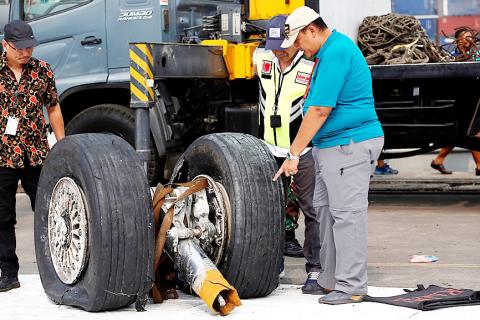Divers reported seeing the fuselage and engines of Lion Air flight JT610 on the seafloor and a ping locator had detected a signal that might be from the cockpit voice recorder, Indonesian National Search and Rescue Agency officials said yesterday.
“Two engines and more landing gear have been found,” agency head Muhammad Syaugi said.
“I haven’t seen it myself, but I got information from some divers that they have seen the fuselage,” Syaugi said.

Photo: Reuters
The brand-new Boeing 737 MAX 8 jet on Monday plunged into the Java Sea just minutes after takeoff, killing all 189 people onboard.
The plane nosed downward so abruptly that it might have reached speeds of 965kph or more before slamming into the sea, according to three experts who made calculations based on preliminary flight-tracking data.
It dived with little or no turns and its nose was pointed about 45 degrees below the horizon shortly before impact, an unusually steep dive for an airliner, according to the analysis of data provided by flight-tracking company FlightRadar24.
Syaugi said that a “low ping signal” was detected that could be the black box voice recorder.
“We have made major breakthroughs, as we have recovered two turbines, one wheel,” Syaugi said. “There are reports of team members seeing the body of the plane.”
However, diver Syachrul Anto, 48, who was volunteering in the search operations, died on Friday.
“He was a volunteer with the Search and Rescue Agency,” Isswarto, commander of the Indonesian Navy’s search and rescue division, told reporters.
It is believed he died from decompression, Isswarto said.
Anto had previously served in Palu after it was struck by an earthquake and tsunami in September and also took part in the evacuation process of an Air Asia plane crash nearly four years ago.

The US government has signed defense cooperation agreements with Japan and the Philippines to boost the deterrence capabilities of countries in the first island chain, a report by the National Security Bureau (NSB) showed. The main countries on the first island chain include the two nations and Taiwan. The bureau is to present the report at a meeting of the legislature’s Foreign Affairs and National Defense Committee tomorrow. The US military has deployed Typhon missile systems to Japan’s Yamaguchi Prefecture and Zambales province in the Philippines during their joint military exercises. It has also installed NMESIS anti-ship systems in Japan’s Okinawa

‘WIN-WIN’: The Philippines, and central and eastern European countries are important potential drone cooperation partners, Minister of Foreign Affairs Lin Chia-lung said Minister of Foreign Affairs Lin Chia-lung (林佳龍) in an interview published yesterday confirmed that there are joint ventures between Taiwan and Poland in the drone industry. Lin made the remark in an exclusive interview with the Chinese-language Liberty Times (the Taipei Times’ sister paper). The government-backed Taiwan Excellence Drone International Business Opportunities Alliance and the Polish Chamber of Unmanned Systems on Wednesday last week signed a memorandum of understanding in Poland to develop a “non-China” supply chain for drones and work together on key technologies. Asked if Taiwan prioritized Poland among central and eastern European countries in drone collaboration, Lin

TRAGEDY STRIKES TAIPEI: The suspect died after falling off a building after he threw smoke grenades into Taipei Main Station and went on a killing spree in Zhongshan A 27-year-old suspect allegedly threw smoke grenades in Taipei Main Station and then proceeded to Zhongshan MRT Station in a random killing spree that resulted in the death of the suspect and two other civilians, and seven injured, including one in critical condition, as of press time last night. The suspect, identified as a man surnamed Chang Wen (張文), allegedly began the attack at Taipei Main Station, the Taipei Fire Department said, adding that it received a report at 5:24pm that smoke grenades had been thrown in the station. One man in his 50s was rushed to hospital after a cardiac arrest

ON ALERT: Taiwan’s partners would issue warnings if China attempted to use Interpol to target Taiwanese, and the global body has mechanisms to prevent it, an official said China has stationed two to four people specializing in Taiwan affairs at its embassies in several democratic countries to monitor and harass Taiwanese, actions that the host nations would not tolerate, National Security Bureau (NSB) Director-General Tsai Ming-yen (蔡明彥) said yesterday. Tsai made the comments at a meeting of the legislature’s Foreign Affairs and National Defense Committee, which asked him and Minister of National Defense Wellington Koo (顧立雄) to report on potential conflicts in the Taiwan Strait and military preparedness. Democratic Progressive Party (DPP) Legislator Michelle Lin (林楚茵) expressed concern that Beijing has posted personnel from China’s Taiwan Affairs Office to its